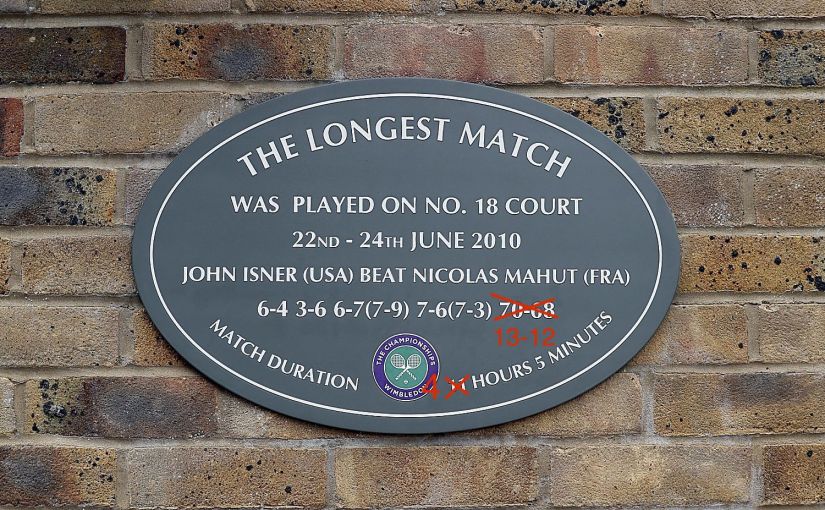
Of all the potential options for change much-debated after the late-tournament drama at this year’s Wimbledon, a fifth-set tiebreak at 12-12 seemed the more recurring one.
And so, on Friday, the All-England Club announced just that. Beginning in 2019, a tiebreak will be played when (if) the score reaches 12-12 in the final set.
That’s the fifth set for the men, the third set for the women and juniors.
“In reaching this decision, the AELTC Committee sought the feedback of both players and officials, analyzed two decades of match data, and considered other factors including scheduling complexities and spectator experience,” AELTC Chairman, Philip Brook said in a statement.
“Our view was that the time had come to introduce a tie-break method for matches that had not reached their natural conclusion at a reasonable point during the deciding set. While we know the instances of matches extending deep into the final set are rare, we feel that a tie-break at 12-12 strikes an equitable balance between allowing players ample opportunity to complete the match to advantage, while also providing certainty that the match will reach a conclusion in an acceptable timeframe.”

As well, it’s worth noting that while this was going on, young Brit Jack Draper was going 19-17 in the deciding set (with two tiebreaks in the first two sets) with Nicolas Mejia of Colombia.
Despite having a day off before the final against Chun Hsin Tseng, he came out very gingerly against him in the first set before catching a second wind. But it might well have made the difference as he was beaten 1-6, 7-6, 6-4.
No 7-6 for the AELTC
Allow us to translate:
“We realized at the time that 70-68 (Nicolas Mahut and John Isner in 2010) was completely out of hand. But we didn’t want to make a knee-jerk decision based on ONE outlier match. When a second instance – albeit a match far shorter in length but far deeper into the tournament – came along this year, we heard all the calls. And we had to do something humane for these two big-serving gentlemen and their brethren. In the wake of the lengthy semifinal, it was clear that the matchup of former champions that followed it was compromised. And that the final was compromised. We couldn’t offer our patrons the spectacle they so richly deserve in the member’s enclosure and the Royal Box.
“That said, we wanted it to be OUR decision. Because we are THE Championships. As well, we knew that once we got together with the other Grand Slam tournaments in Singapore, those pesky Americans would get in our grill. They’d blather on about their final-set tiebreak atrocity and try to get everyone on the same page. Therefore, as a pre-emptive strike, we are announcing this decision. We aim to be both proactive and forward-thinking, and send the message that we will do as we see fit, at all times. Because we are WIMBLEDON.”

Anderson v Djokovic impacted
As laudable as it was for the South African Kevin Anderson to reach the Wimbledon final, the toll the five-set, 26-24 victory over Isner in the semifinal took was evident. Especially at the end of a long fortnight – and especially against the resurgent Novak Djokovic. It was a fatal blow.
Understandably, he didn’t have much left. And despite the novelty of a match going for so long, it’s not as though it was all that enjoyable for the fans, either.
Not only that, it crushed a semifinal schedule already limited because of morning dew and daylight. If it goes overtime, the roof and the changing conditions can come into play for the duration of the schedule.
And no, no more of that.

Happiest fellow: Isner
Isner, who ended up on the short end of that semifinal, also was involved in what will now – for time immemorial – remain the longest match in tennis history.
That one, in the first round of the 2010 event on Court 18 against France’s Nicolas Mahut, went … 70-68 in the fifth set. It also went on for three days.
When Isner arrived for his second-round match against Thiemo de Bakker of the Netherlands, he was still toast. The American won just five games in a straight-sets defeat. That one took … an hour and 14 minutes.
He also went 19-17 in the fifth, against Jo-Wilfried Tsonga in the third round in 2016. And he lost that one too, after being up two sets to love.
The Centre Court roof precedent
One thing we know to be a virtual certainty: now that Wimbledon has taken this step, there won’t be a single match at Wimbledon next year that will go to the “new” limit.
The precedent for that is Wimbledon’s Centre Court roof, retrofitted to the Grand Olde Building for the 2009 edition.
Since then – we’ve all noticed – it has barely rained at Wimbledon. And the retractable roof has often been used to finish evening matches.
With the new roof over No. 1 Court to be premiered in 2019, we predict that it won’t rain again next year, either.
But Isner can rest comfortably, knowing he won’t ever have to go through this again.
He might even win the whole thing.

More Stories
The reinvention of Newport, starring … Bill Ackman
Wimbledon Day 10 – Doubles, mixed, legends results
Wimbledon Day 10 – Singles results